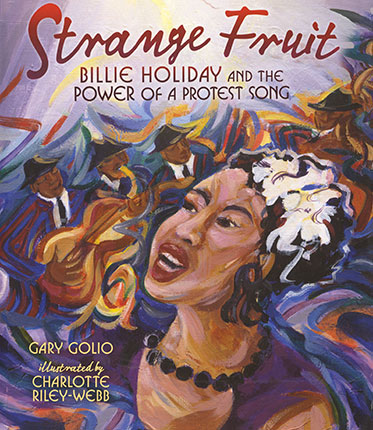Full Text Reviews: Booklist - 12/01/2016 At first glance, the picture-book format seems an odd choice for this minibiography, directed at middle-schoolers, of jazz legend Holiday and her signature song about the horrors of lynching. The vivid imagery of the lyrics and the reality underlying them are strong stuff for young sensibilities. The lengthy, text-heavy narrative follows the challenges Billie Holiday faced as a light-skinned black musician (she was often hidden from white patrons but was “too white for an all-black band”) before segueing into her first introduction to Abel Meeropol’s “Strange Fruit” and the effects the song had on audiences. Riley-Webb’s full-bleed acrylic illustrations are remarkably effective. Often abstract, they portray the jazz world and racial tensions of the era just before the civil rights movement. Adults will immediately catch many of the oblique references, though uninformed middle-graders will remain clueless. The format and back matter make this most useful in a classroom setting where it should prompt a discussion about one of the darkest times in U.S. history. - Copyright 2016 Booklist. School Library Journal - 01/01/2017 Gr 3–6—Singer Billie Holiday had a knack for jazz improvisation and dramatic performance, but she emerged from a difficult childhood into a world that didn't support black success. In 1938, she found a singing home in an integrated Greenwich Village club called Cafe Society. When its owner asked Holiday to sing Abel Meeropol's haunting song "Strange Fruit," she made it her own, eventually performing it throughout the country. While a song about lynching may seem a challenging choice for a picture book subject, the combination of words and images here is strikingly effective. Riley-Webb's emotionally expressive illustrations are as forceful as the topic. Done with acrylic paint and tissue collage, they are full of rough textures, curved lines, and grasping hands. In a smoothly written text, with important ideas emphasized in a larger font, Golio briefly summarizes Holiday's early life and career. He leaves out most of the seamier details and concludes his narrative with accounts of two early performances of this haunting song, the first in a private apartment in Harlem and the second in the club. Back matter includes the lyrics and two pages of exposition that define lynching and describe the subsequent history of the song and the singer. VERDICT This is not an easy book, but it is powerful—just like its theme. Consider for guided in-depth discussions on Billie Holiday and U.S. history.—Kathleen Isaacs, Children's Literature Specialist, Pasadena, MD - Copyright 2017 Publishers Weekly, Library Journal and/or School Library Journal used with permission. Loading...
|



